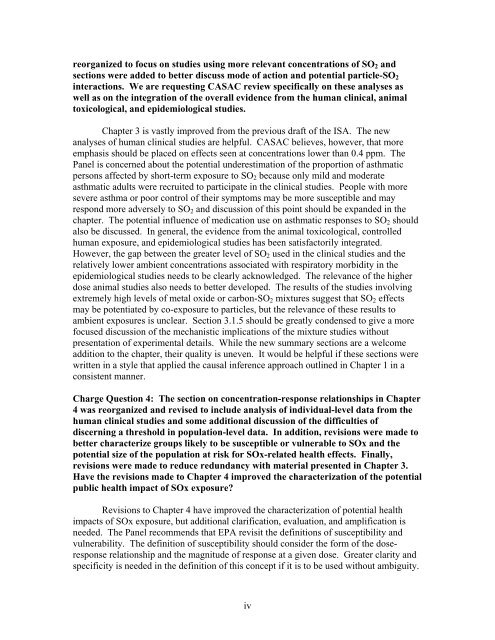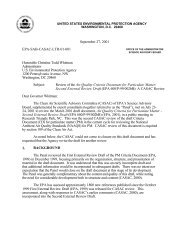(CASAC) Peer Review of EPA's Integrated Science Assessment
(CASAC) Peer Review of EPA's Integrated Science Assessment
(CASAC) Peer Review of EPA's Integrated Science Assessment
You also want an ePaper? Increase the reach of your titles
YUMPU automatically turns print PDFs into web optimized ePapers that Google loves.
eorganized to focus on studies using more relevant concentrations <strong>of</strong> SO 2 andsections were added to better discuss mode <strong>of</strong> action and potential particle-SO 2interactions. We are requesting <strong>CASAC</strong> review specifically on these analyses aswell as on the integration <strong>of</strong> the overall evidence from the human clinical, animaltoxicological, and epidemiological studies.Chapter 3 is vastly improved from the previous draft <strong>of</strong> the ISA. The newanalyses <strong>of</strong> human clinical studies are helpful. <strong>CASAC</strong> believes, however, that moreemphasis should be placed on effects seen at concentrations lower than 0.4 ppm. ThePanel is concerned about the potential underestimation <strong>of</strong> the proportion <strong>of</strong> asthmaticpersons affected by short-term exposure to SO 2 because only mild and moderateasthmatic adults were recruited to participate in the clinical studies. People with moresevere asthma or poor control <strong>of</strong> their symptoms may be more susceptible and mayrespond more adversely to SO 2 and discussion <strong>of</strong> this point should be expanded in thechapter. The potential influence <strong>of</strong> medication use on asthmatic responses to SO 2 shouldalso be discussed. In general, the evidence from the animal toxicological, controlledhuman exposure, and epidemiological studies has been satisfactorily integrated.However, the gap between the greater level <strong>of</strong> SO 2 used in the clinical studies and therelatively lower ambient concentrations associated with respiratory morbidity in theepidemiological studies needs to be clearly acknowledged. The relevance <strong>of</strong> the higherdose animal studies also needs to better developed. The results <strong>of</strong> the studies involvingextremely high levels <strong>of</strong> metal oxide or carbon-SO 2 mixtures suggest that SO 2 effectsmay be potentiated by co-exposure to particles, but the relevance <strong>of</strong> these results toambient exposures is unclear. Section 3.1.5 should be greatly condensed to give a morefocused discussion <strong>of</strong> the mechanistic implications <strong>of</strong> the mixture studies withoutpresentation <strong>of</strong> experimental details. While the new summary sections are a welcomeaddition to the chapter, their quality is uneven. It would be helpful if these sections werewritten in a style that applied the causal inference approach outlined in Chapter 1 in aconsistent manner.Charge Question 4: The section on concentration-response relationships in Chapter4 was reorganized and revised to include analysis <strong>of</strong> individual-level data from thehuman clinical studies and some additional discussion <strong>of</strong> the difficulties <strong>of</strong>discerning a threshold in population-level data. In addition, revisions were made tobetter characterize groups likely to be susceptible or vulnerable to SOx and thepotential size <strong>of</strong> the population at risk for SOx-related health effects. Finally,revisions were made to reduce redundancy with material presented in Chapter 3.Have the revisions made to Chapter 4 improved the characterization <strong>of</strong> the potentialpublic health impact <strong>of</strong> SOx exposure?Revisions to Chapter 4 have improved the characterization <strong>of</strong> potential healthimpacts <strong>of</strong> SOx exposure, but additional clarification, evaluation, and amplification isneeded. The Panel recommends that EPA revisit the definitions <strong>of</strong> susceptibility andvulnerability. The definition <strong>of</strong> susceptibility should consider the form <strong>of</strong> the doseresponserelationship and the magnitude <strong>of</strong> response at a given dose. Greater clarity andspecificity is needed in the definition <strong>of</strong> this concept if it is to be used without ambiguity.iv
















